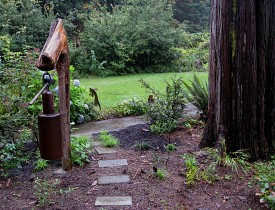Cope With Water Shortages By Xeriscape Gardening
 Xeriscaping, quite untrue to its potential to support colorful blooms throughout the seasons, has gotten an unfair association with rock gardens with cacti. While in some climates it is true that cacti are native plants that would be appropriate components of a xeriscape garden, xeriscape gardens actually can be full of lush blooms.
Xeriscaping, quite untrue to its potential to support colorful blooms throughout the seasons, has gotten an unfair association with rock gardens with cacti. While in some climates it is true that cacti are native plants that would be appropriate components of a xeriscape garden, xeriscape gardens actually can be full of lush blooms.
"Xeri" is a prefix derived from the word for "dry" in Greek. So xeriscaping is a technique of gardening that requires only minimal irrigation, ideally using rainwater only. Native plants and mulches that help to retain moisture in the ground are the cornerstones of xersicape gardening.
Native plants and moisture-retaining mulches are two components of the Seven Principles of Xeriscape Gardening. Let's look at each of the Seven Principles of Xeriscape Gardening, to find out how they each allow for lush blooms with minimal irrigation.
Planning and design: There are many factors involved in planning a successful xeriscape garden. A good plan will integrate zones of watering and drainage, sun and shade, existing plants, and uses of space (like outdoor living areas).
Soil analysis: Before amending soil, it's crucial to find out what nutrients your soil is rich in, and which nutrients it lacks, as well as the pH of your soil. Many (bordering on most) university extension services offer soil testing services, and their experts can help you to get your soil back in shape to support the growth of plants native to your area.
Appropriate plant selection: Part of successful xeriscape gardening is selecting plants that thrive in your region with minimal watering. Another part is placing those plants in the right place (sun vs. shade).
Turf planning: Turf can be a valuable part of a xeriscape garden. Since xeriscape gardens are an alternative to water-intensive lawns, you'll need to plan your turf carefully. Drought-friendly native groundcovers and low-water varieties of grass can be integrated into a xeriscape garden.
Efficient irrigation: During their first few years, xeriscape gardens need consistent watering in order to establish the root systems of the plants. After a few years, they can thrive with little to no irrigation. Drip irrigation is the preferred method of irrigation for xeriscape garden plants, while sprinklers are appropriate for turf. Watering the right amount, at the right time of day, will ensure the best water efficiency and results.
Mulching: Mulch does two great things in a xeriscape garden. It protects soil from moisture loss. Mulch also limits and prevents the growth of weeds. There are many types of mulch available, from pine bark to gravel to newspaper. Each has its advantages and disadvantages, although pine bark seems to be an all-around winner.
Maintenance: Even though xeriscape gardens are meant to be low-maintenance, like all gardens they require some maintenance. You can expect to weed, fertilize, and prune the plants in a xersicape garden, though with a lighter hand than in a conventional garden.
Xeriscape gardens are not just for desert or high-country landscapes. Every climate and gardening zone has its native plants, which can be planted using the Seven Principles of xeriscape gardening. Whether you live in Florida, Texas, Oklahoma, or New Hampshire, xeriscaping can allow you to enjoy a lush garden with colorful blooms even when water for irrigation is scarce.
Looking for a Pro? Call us (866) 441-6648

Landscaping Average Costs
Landscapers Experiences

Concrete Patio Is The Finishing Touch For An Artist's Studio

Friendly And Professional Lawn Service Earns My Loyalty



